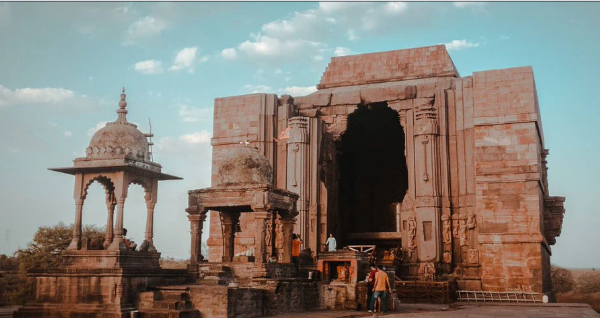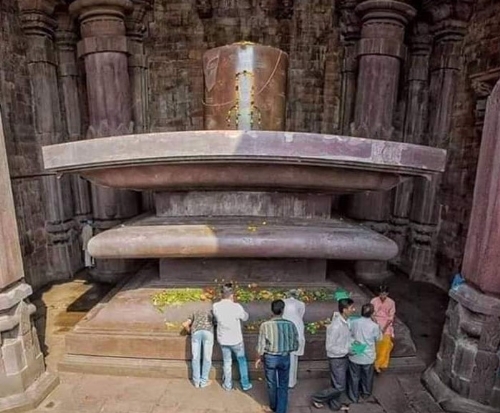Bhojeshwar: The story of an incomplete Shiva temple
If it had been completed, it would have been one of the largest temple complexes in India, and could have even taken a vital place among the famous jyotirlingas
Total Views |
We have all heard of the great Jyotirlinga temples of India. Right from the North to the South of India, from Kedarnath to Rameshwaram, you will find a fine line, with the famous Shiva temples, which are the 12 mysterious jyotirlingas. One temples which could have been a part of this list, is the Bhojeshwar temple near Bhopal, as this temple has the pride of having one of the tallest shivalingas present in the country!

 Historians have speculated that this could have taken place due to a natural disaster, war, or the even the scarcity of natural resources. The raw material, unfinished portions, the architectural plans carved into the stone have been found abandoned around the temple. The detailed architectural plans for the finished temple can still be seen scoured into the rock of the quarry. If these plans had been fulfilled, it would have been one of the largest temple complexes in India.
Historians have speculated that this could have taken place due to a natural disaster, war, or the even the scarcity of natural resources. The raw material, unfinished portions, the architectural plans carved into the stone have been found abandoned around the temple. The detailed architectural plans for the finished temple can still be seen scoured into the rock of the quarry. If these plans had been fulfilled, it would have been one of the largest temple complexes in India.
If it had been completed, it would have been one of the largest temple complexes in the country, and could have even taken a vital place among the famous jyotirlingas. Even though incomplete, the temple still stands as a testimony to the remarkable brilliance that was possessed by the Indian sculptors and temple builders in the ancient time!

The brilliance seen in Indian architecture is often exhibited through the temples built in the ancient times. Many times, even an incomplete work still manages to depict the craftsmanship of the creator! Devoted to Lord Shiva, Bhojeshwar Temple is the well-known religious and historical monument in located in the village of Bhojpur, along the banks of the Betwa river, in Madhya Pradesh. This temple houses one of the largest Shivalings in the world.
History | The work on the temple was started by Raja Bhojdev (1010-1055 AD), the ruler of Malwa. He lived in his capital, Dhar, and was a great connoisseur of art, literature and science. According to the local folklore, he is known to have founded the settlement of Bhopal, which was originally called as Bhojpal.
In Bhojpur, Raja Bhoj is said to have built three large earthen dams and created a massive reservoir that was destroyed later by Sultan Hoshang Shah of Malwa. On the banks of this reservoir, he built a colossal Shiva temple, called the Bhojeshwar temple, with a massive shivling measuring 7.5 ft in height and 17.8 ft in circumference. It is set on a square platform. The total height of the linga, including the platform, is 40 feet, making it the tallest one in India! It is made up of 3 limestone blocks placed over each other.

The exact date of construction is unknown, but according to historian Dr. Kirit Mankodi, it dates back to the later portion of Raja Bhoj’s reign – around mid-11th century CE. However, the work was never completed, as it abruptly stopped midway. The evidence of this can be seen all over the site. Why did the temple remain unfinished? Did a natural calamity like an earthquake strike damaging the temple? Was it a case of faulty engineering? Or was it the pillage by invaders? We still do not have any clear answer to this mystery.
Also Read | Gangaikonda Cholapuram temple: The ancient pride of the Chola dynasty!
In the year 2006-07 an ASI team, which archaeologist KK Muhammad led, took efforts to conserve the temple. According to him, one of the reasons the temple was left unfinished was because, the calculations show that the structure was not able to bear the load of the stone roof, and hence it collapsed. After this, the king wasn’t able to rebuild the temple in order to complete it. The original architecture plans do show a much larger temple complex planned by Raja Bhoj but was never built.
If it had been completed, it would have been one of the largest temple complexes in the country, and could have even taken a vital place among the famous jyotirlingas. Even though incomplete, the temple still stands as a testimony to the remarkable brilliance that was possessed by the Indian sculptors and temple builders in the ancient time!


